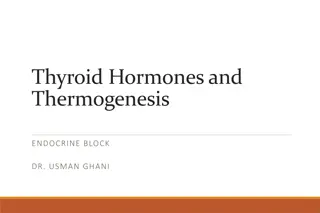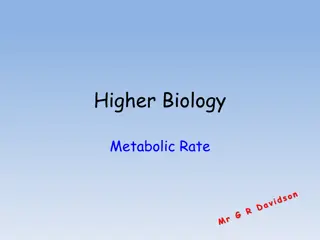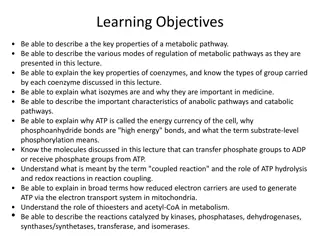Understanding Metabolic Control Mechanisms in Cellular Regulation
Metabolic control mechanisms play a crucial role in maintaining homeostasis within cells by regulating metabolic pathways. This involves finely adjusting the output of pathways in response to external signals, ensuring the proper flux of metabolites to meet cellular needs. Pacemaker enzymes, such as phosphofructokinase, are key regulators in controlling pathway flux. The mechanisms of metabolic control are classified as coarse and fine, each with distinct timeframes and energy requirements for bringing about changes in enzyme velocity. Coarse control involves adjusting the total enzyme population through processes like protein synthesis and degradation. Overall, a delicate balance of regulatory processes ensures metabolic homeostasis in biological systems.
Download Presentation

Please find below an Image/Link to download the presentation.
The content on the website is provided AS IS for your information and personal use only. It may not be sold, licensed, or shared on other websites without obtaining consent from the author. Download presentation by click this link. If you encounter any issues during the download, it is possible that the publisher has removed the file from their server.
E N D
Presentation Transcript
BTG 406 Metabolic Engineering Metabolic Control Mechanisms Anadozie, S.O Ph.D.
Metabolic Control Mechanisms The metabolic pathways are complex and interdependent. With the changing environments, the reactions of metabolism must be finely regulated to maintain a constant set of conditions within cells, a condition called homeostasis. The regulation of mammalian blood glucose is largely due to the secreted peptide hormones glucagon ( starved "signal) and insulin ( fed signal) controlling intracellular metabolism within the liver. In this case, the concentration of blood glucose is regulated (kept constant) mainly by controlling (varying) fluxes of metabolic pathways (i.e. glycogen breakdown versus synthesis, glycolysis, gluconeogenesis) in hepatocytes.
Overview of Metabolic Control Mechanisms The flux of metabolites through any pathway must be closely coordinated with the needs of the cell, tissue, or organism for the final end product(s) of the pathway. Regulation and control are properties of highly elaborate metabolic systems. Metabolic Control is the process of adjusting the output of a metabolic pathway in response to an external signal (i.e monitoring the effect of changes caused by the enzymatic activity on the turnover rate of the pathway). Metabolic Control has influence on the homeostasis.
Basis of Metabolic Control: Pacemaker Enzymes The traditional view of metabolic control is that such regulation is accomplished by altering the activity of at least one pacemaker enzyme (or rate-determining step) of the pathway. Thus, a major focus of enzymology has been to characterize these key enzyme reactions-the pacemakers, that are believed to be most important in controlling pathway flux. Phosphofructokinase (PFK) is generally considered to be an important pacemaker enzyme of the glycolytic pathway. It catalyzes the first unique step of glycolysis, a non equilibrium reaction in vivo and shows a strong positive crossover concomitant with glycolytic stimulation. The magnitude of metabolite flux through any metabolic pathway will depend upon the activities of the individual enzymes involved.
MECHANISMS OF METABOLIC CONTROL The mechanism of metabolic control is divided into two major classes on the basis of the relative lengths of time they take to bring about a change in the velocity of a particular enzyme. These are coarse and fine metabolic control. Coarse metabolic control is a long-term (hours to days in eukaryotes; perhaps minutes to hours in rapidly growing prokaryotes), energetically expensive, response that is achieved through changes in the total cellular population of enzyme molecules. The process is slow as it involves protein synthesis. The total amount of a given enzyme is dependent upon the relative rates of its biosynthesis versus degradation. Thus, any alteration in the rates of gene expression (i.e. transcription, translation, mRNA processing or degradation) or proteolysis can be considered as coarse metabolic control.
1. Coarse Metabolic Control (Gene Expression) Coarse control can be applied to one or all the enzymes in a particular pathway and most frequently comes into play in response to hormonal stimulation and/or during tissue differentiation or long-term environmental (adaptive) changes. In the context of metabolic control it is important to note that an underlying assumption of many genomic studies is that the expression of a gene at the mRNA level is a quantitative indicator of function of the encoded enzyme. Thus, an n-fold increase in transcript levels (detected via Northern blots or gene chip screening) equates to n-fold more enzyme & hence n-fold more activity. However, it is becoming apparent that this assumption does not always reflect reality.
Coarse Metabolic Control (Protein Turnover) Relative to gene expression, much less is known about the mechanisms governing protein degradation Animal and plant enzymes that coexist in the same cellular compartment may exhibit vastly different turnover rates, ranging from several minutes to hundreds of hours. In general, larger, oligomeric proteins that display complex biological properties and significant hydrophobicity tend to show much shorter half-lives in vivo than do less complex monomeric (and/or less hydrophobic)proteins. It is clear that proteolysis of enzymes can be selectively targeted and may be initiated in response to specific stimuli.
Selection of Enzymes for Intracellular Degradation Many enzymes need to first become tagged before becoming susceptible to degradation by endogenous proteases. The formation of a peptide bond between the target enzyme and a protein called ubiquitin are types of covalent modification used for tagging enzymes for degradation. Modification of the protein by phosphorylation or by oxidation can also be used for tagging enzymes for degradation. Ubiquitin (Mr9000) is so-called because of its widespread occurrence in eukaryotic cells. Its role in protein turnover has been well-established in animals and plants. Certain proteins destined for degradation are covalently bonded to ubiquitin via the NH2 groups of lysine residues. A single protein may become tagged with many ubiquitin molecules.
Selection of Enzymes for Intracellular Degradation ATP is required for the ubiquitin conjugation, together with several enzymes. Another method of tagging an enzyme for protease degradation is by phosphorylation, which again is dependent upon the hydrolysis of ATP, in this case by the modifying protein kinase. The ATP requirement of the ubiquitin and phosphorylation tagging systems reflects the bioenergetic cost for endowing the cell with proteolytic specificity. Although tagging methods appear to make many enzymes susceptible to proteolytic attack in vivo, it is not yet clear precisely which features of the target enzymes are recognized by the tagging machinery.
2. Fine Control Fine control: This is a fast process (i.e., seconds to minutes) as it involves changing the activity of enzyme already available in the cells. Fine metabolic controls are also regarded as metabolic transducers Operating primarily on the regulatory or peace maker enzyme(s) of a pathway, fine controls allow the cell to prevent metabolic chaos.
Fine Control: Alteration in Substrate Concentration The rate of an enzyme-catalyzed reaction is dependent upon substrate ([S]) when [S] is sub-saturating. Substrate concentrations for most enzymes are sub-saturating in vivo. Often the in vivo [S] is less than or nearly equal to the Km or S0.5 value of the enzyme for that substrate. The main exception to this are enzymes such as nucleases, proteases, lipases, phosphorylases, or amylases that catalyse initial steps in macromolecule catabolism, cases where substrate reserves (i.e., glycogen, triglycerides deposits) are huge. Not all enzymes show simple Michaelis-Menten kinetics, however. Multimeric enzymes (i.e., consisting of two or more polypeptides in their native state) often contain more than one substrate binding site. Binding of substrate to one subunit can affect the conformation of other subunits and positively enhance the binding of substrate to them. The result of such cooperative binding of substrate is a sigmoidal relationship between enzyme activity and [S]. This is known as allosteric
Fine Control: variation in pH Most enzymes have a characteristic pH at which their activity is maximal (optimum pH). Above or below this pH the activity normally declines, although to varying degrees depending upon the particular enzyme. Thus, enzymes can show pH versus activity profiles ranging in shape from very broad to very narrow. The pH optimum of an enzyme is not always the same as the pH of its intracellular surroundings, this suggests that the pH dependence of enzyme activity may be one factor that determines its overall activity in the cell.
Fine Control: variation in pH Cells contain thousands of enzymes, many of which show different responses to pH, the intracellular pH (pHi) may represent an important element of fine metabolic control. The light-dependent activation of several enzymes of the reductive pentose phosphate pathway (Calvin Benson cycle) provides a well-documented example of how changes in pHi can contribute to metabolic control within the chloroplast stroma of plants Photosynthetic electron transport has been linked to H+ uptake from the stroma into the thylakoid lumen, and thus, establishes a proton gradient between the lumen and stroma that drives the photophosphorylation of ADP by Pi (inorganic phosphate) to form ATP.
Fine Control: Allosteric Effectors Multisubunit regulatory enzymes often contain allosteric sites that are separate from the active or catalytic site where specific inhibitor or activator metabolites can bind reversibly. By varying the concentration of these non-substrate effector molecules, it is possible to markedly alter the activity of an enzyme and thereby modify the flux of metabolites through an entire pathway. Allosteric effectors alter enzyme activity by binding to an allosteric site and eliciting a precise change in the enzyme s conformation termed heterotropic allosterism. Allosteric effectors themselves may show hyperbolic or sigmoidal (i.e., cooperative) saturation kinetics.
Fine Control: Allosteric Effectors A sigmoidal relationship allows sensitive response of enzyme conformation (and hence activity) to changes in effector concentration. The conformational change brought about by the binding of an allosteric effector promotes (activators) or hinders (inhibitors) enzyme substrate interactions such that some or all of the kinetic constants may be significantly altered including Vmax, Km or S0.5, and nH. This regulatory strategy allows metabolites that are remote from a specific reaction to function as feedforward (activators) or feedback (inhibitors) control signals on enzyme activity. All pacemaker enzymes are at least partially controlled by allosteric effectors.
Reversible Covalent Modification /Interconvertible Enzyme Cascade This type plays a dominant role in fine metabolic control. A wide variety of posttranslational modifications of proteins can have an influence on enzymatic activity. An enzyme is interconverted between a less active (or inactive) and more active form which is usually governed by two thermodynamically favourable enzyme-catalyzed reactions that result in the formation of new stable covalent bonds on the surface of the target enzyme. A change in enzyme conformation that is induced by covalent modification normally causes an alteration of enzyme substrate interactions such that kinetic parameters such as Vmax, Km.
Reversible Covalent Modification /Interconvertible Enzyme Cascade Covalent modification can quickly provide the cell with an essentially new enzyme form whose kinetic properties are geared to the cell s momentary metabolic requirements. Enzyme control by reversible covalent modification is the major mechanism whereby extracellular signals, such as hormones, nervous impulses & numerous environmental stimuli, can coordinate the control of key enzymes of intracellular pathways. Reversible covalent modification of enzymes typically allows a very marked sensitivity (e.g., amplification ) to signals. Reversible ADP-ribosylation, methylation, and adenylation also con-tribute to the fine control of various enzymes in eukaryotesand/or microbes.























